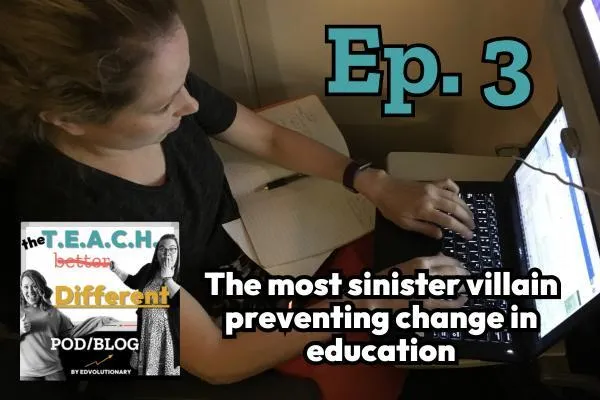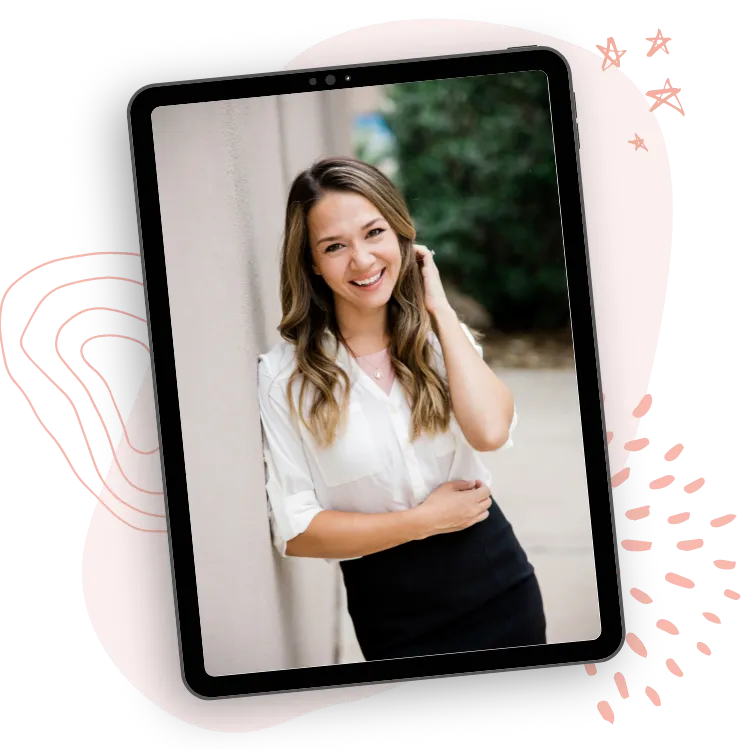BLOG
Suspendisse pulvinar metus vitae finibus interdum

3: The most sinister villain preventing change in education
Listen to the episode:
This week's post is brought to you by the letter T! Learn more about the TEACH Framework here.
Get notified about our TEACH Different Community- opening in July!
Post/Episode Summary:
I bet you can name a lot of villains in the education world.
These are the people and institutions that seem to be out of touch with the realities in classrooms and don't seem to be making anything better anytime soon.
Today we talk about the sneakiest one. Did it make your list?
Guess you'll have to listen to find out....
Beware of the compliance police ghost
Annie and I met the summer of 2020 when I discovered a job posting for a part time role teaching K/1 math in her public k/1 classroom. I had just completed a 9 month Montessori certification course and was super stoked about bringing that toolbox (along with my 8 years of elementary teaching experience) into a primary math environment to figure out how we could create space where students could be more self-directed learners… especially in math which is notorious for turning many of us into helpless blobs.
In my interview I bonded immediately with her and our principal. It felt like a meeting of old educational soulmates and total destiny… which I still believe it was but not the point of this story.
Every day I showed up to work, testing out my theories and revising my approach as I experienced lots of failure mixed in with occasional brilliant moments of success.
And despite the fact that I had come into a place that clearly shared my values for empowering students….every day I was terrified that someone would see something I did and think I wasn’t meeting expectations. And this was during COVID when no one was even allowed to walk into our classroom.
I remember one day sending my principal some kind of email panicked about something I thought I should be doing and she said calmly to me, “Ali… you know there’s no compliance police right?”
NO. My brain DID NOT seem to know there was no compliance police. Even though noone at my new school had ever communicated that I shouldn’t be trying to do exactly what I was doing and most people were intrigued by what I was trying to pull off… I was afraid of the compliance police ghost around every proverbial corner.
In my head AND in some of the innocuous structures baked into how we analyzed and assessed what we were doing… I was paralyzed between the tension of doing what I thought I was “supposed to be doing as “good teacher”” and doing what I authentically thought was going to be best for students and their long-term learning and wellbeing.
And for two years… I tried to bob and weave from this exhausting compliance police ghost… rather than face him head on… realize he was mostly an apparition instead of real threat… and move forward in a way that would have benefitted me and my students much more.
I know deep in my soul that that flip flopping extended the time it took for me to figure out the key ingredients in the approach to student-directed learning that Annie and I are now building out at edvolutionary… unnecessarily and to plenty of detriment to my own mental health and exhaustion for my physicial health.
WHY?
And what does this story have to do with you? Let’s unpack it.
A SNEAKY contributor to teacher burnout
The story I opened with was chosen to illustrate something that probably affects you more than you imagine. And it’s standing in the way of both your own wellbeing as a teacher but also our collective capacity to transform education in the ways we know it desperately needs to be evolved.
So let’s set the stage for what I’m talking about:
There is not a teacher I’ve spoken to that is not frustrated with what they are being asked to juggle today with no additional money, resources, or support… and sometimes even less support than usual because of all the staff attrition.
When in our classrooms with the colleagues that make up our own circles of safety, we teachers vent endlessly about the seemingly out of touch decisions of administration, district leadership, state and federal policy– all the people out there who tell us what to do and how to do it. Its partially how we survive.
Why… we wonder… don’t they get it? Can’t they see the writing on the wall and that everything is falling apart and something needs to be done about it?
But then another decision comes down the pike geared to solve yet another facet of the challenges facing schools by putting another initiative on teacher’s plates.
WTH we think to ourselves and scream at each other.
Well…and here’s the part you might not like to hear. Take a deep breath. Are you ready for it? Sure you can handle it? Okay I”m going to say it anyway.
Maybe part of it is because WE keep jumping through all the hoops they put up for us.
Before you get mad, hear me out.
We teachers sit in multi-hour after school meetings and perform engagement–no other way to describe it– unpacking how to write the perfect student language objective to support an academic learning target when we know there are 500 more high leverage things our students and us need much more urgently than that. Tomorrow.
We often go through the motions of the teacher proof curriculums we’re mandated to perform– bemoaning our lack of support when student behavior gets completely out of control because they are bored or unable to access what some curriculum calendar has decided they should know that day.
We show up to data teams with proof that our kindergarteners can count to 20 because it’s the third tuesday in November and we’ve been arbitrarily told that that is what is important that day even though we know our students and that there were other high leverage things that would move their learning forward so much more effectively than focusing on this one isolated thing at this one isolated time so we could prove we were doing a good job.
Feeling attacked? Me too.
If you're brand of perseverance isn't one of these I bet you can quickly figure out what it is.
And deep down, we know many, if not most of these things are tanking us and not making much of a difference in student outcomes. Or making student outcomes worse when our own abilities are diminished by overwhelm.
And yet… we persevere.
Why?
Stop trying to be "good."
A few weeks ago I heard about a book called On Our Best Behavior: The Seven Deadly Sins and the Price Women Pay to Be Good by Elise Loehnen on the Marie Forleo podcast and it all started to come into focus. You can listen to the full episode here.
In her book, Loehnen talks about the cultural conditioning that keeps people… primarily women…which fyi makes up 74.3% of the teaching force… in a place of people pleasing that allows US by our own internal volition to essentially keep these oppressive structures operating despite the fact that they are killing us inside and specific to our jobs– overwhelmed to the point that anyone with a basic understanding of brain science and emotional regulation would say is the first thing we need to address if we want to actually be able to support students who are learning to be regulated, engaged learners.
I’m going to share some excerpts from the podcast to give you the gist of her thesis:
Elise Loehnen:
When I was talking about this with my editor, when we were talking about the seven sins and the specificity for women, and I bring it back to that moment, it's not the beginning. We can talk a little bit about the formation of patriarchy if you want, and maybe who we were before that. But the morality that women in that moment became the carriers, the consigned to carry the sin is present today in a way that men are not policing themselves about their goodness.
I write in the book about how within our culture, men are programmed for power and women are programmed for goodness. We wear our goodness like a shield so fearful. Particularly now, it's almost reaching a boiling point of like, "Don't look at me. Don't cancel me. Don't come after me." Just this fear of being called bad or ambitious or greedy or slutty. All of these things that we police in ourselves and then police in each other.
Elise Loehnen:
This is the first chapter I wrote. It's the first chapter in the book because it's, I think, so relatable to all women, which is this idea that there's always more to be done.
Marie Forleo:
Yep.
Elise Loehnen:
There's always doing to do. There are endless needs in the world. As women, we are certainly engineered to meet other people's needs before we consider our own or get to the whole wanting thing. We subjugate our wants to other people's needs. It's how we're acculturated. Again, do anything else, as you were just saying about choosing not to have children, it becomes a whole like, "God, Marie, that's so selfish."
Marie Forleo:
Oh. You know how many times I've heard that? Yeah. She would've been such a great mom. I'm like, "Dude, I'm a stepmom. That's really cool." But it's not selfish. It's like self-knowing.
How often do people say, “put on your own oxygen mask first”?
But we are so, so conditioned that we don’t come first that we literally don’t know how to do that.
And when we do put ourselves first… we feel the judgement, and then our lizard brain tells us we are not safe. So we don’t go there.
But as I said before…this isn’t even just about us. Everything about emotional regulation and brain science and all the things tells us we can not be the kind of regulated adult our students need if we don’t. But we feel like we can’t… and then….
Elise Loehnen:
But this idea that you could put yourself first is so aberrant. I knew this on a mental level. That chapter originally was twice as long. I mean, I took out so many stories to make this book fighting shape, but endless stories. Every woman has endless stories. Sometimes we wear that our busyness, a little bit of a badge of honor. Again, protection against like, "Don't pick on me. Look how hard I'm working."
It just resonates so much...with me at least.
Wanting to be good.
Being busy all the time to stay safe from judgement. Fears that have led to my own burnout time and time again.
One of my favorite quotes in Loehnen’s book further illuminates how we keep ourselves trapped in this cycle. She writes:
"Our greatest imperatives are to belong, to love and be loved in return. Yet life gets in the way. Sometimes interference comes from tangible constraints that are outside our control–traumatic childhoods, systemic injustice, natural disasters– but more frequently, the barriers that keep us from full expression of our potential are intangible. These are the whisperings of self-doubt, limiting beliefs, or social constructs of roles and responsibilities: What’s appropriate for each of us to want and do?
We are giving way our power and accepting exhaustion, resentment, despair and disconnection instead. Meanwhile, the world needs us, just as we are.Even those that don’t believe in a larger spiritual or religious construct seem to agree that developing and making use of your unique gifts–finding and fulfilling your individual, true purpose–is the primary work and point of life.
But we can’t focus on that when we are spending our mental, emotional, and spiritual capital contorting ourselves, pulling ourselves out of balance, and using an abundance of energy to punish ourselves for the very qualities that make us human.Hopefully, the hurdles that bar our progress will continue to fall. If we can get over ourselves.
Until we learn how to give ourselves and each other grace, we’ll struggle to dismantle the parts of society that are toxic and to do the work of building it back anew."
At first it is very demoralizing to realize the enemy is not just outside the gates. But as I’ve learned from voices in the social justice realm like Dr. Shawn Ginwright, author of The Four Pivots: Reimagining Justice, Reimagining Ourselves… social change takes both a lens and a mirror. A lens that can see the external realities that must be undone but also maybe even more importantly….a mirror to ourselves to see how we may be unconsciously upholding them.
What do we do about it?
As far as I see it, each one of us has three choices:
1. You can keep persevering. At some schools you might get the martyr of the week award!
2. You can leave teaching. Plenty of people have. The stigma is pretty much gone at this point.
3. Or… the buck can stop with you… with us.
I once heard Alfie Kohn, one of my favorite education thought leaders say on a podcast:
"You can’t, in this climate, be a really top-notch teacher unless you have the heart of a rebel.
It’s not just about a skill set. It’s about a willingness to actively resist moronic mandates and ideally, collaborate with one's fellow teachers in refusing to go along with it.”
So let’s talk about how we actually do that in practice.
Step 1: Awareness
We need to understand the compliance ghosts in our own head and others need to know about them too or we’ll just feel alone and paralyzed to do anything about it for fear of being ostracized from our group (thanks, reptile brain).
Action: share and talk about the ideas in this episode with education colleagues and friends.
Step 2: Healing
Have you heard this word tossed around recently?
It sounds floofy to our SUCK IT UP conditioned brains.
But we literally can't get out of the habits that keep us persevering and upholding this system if we believe doing so is where our value lies. We need to heal THAT toxic wound STAT.
In her book, Heal Your Way Forward: The Co-Conspirator’s Guide to Antiracism Myisha Hill writes:
"Folx choose to be prisoners to what feels comfortable rather than leaning into the awareness of discomfort that comes from awakening.
We must become self-aware of what is. It is an invitation to let go of the habits that have kept us from stepping into our own healing.
It isn’t until we make the conscious choice to heal that we move away from the idea that a system or series of rules sets the standards for what liberation means for us."
Action: The next 2-3 episodes of TEACH Different coming your way will give you more ideas on how to engage in this healing work and try to have an open mind despite the fact that you might find it easier to just keep on keepin on.
Step 3: Connection
Most of us can’t do this alone. Nor should we.
Although our culture is highly individualistic, that’s not actually how humans are wired. We’re wired for social connection and that provides us safety and the courage to do what needs to be done.
Action items: Submit your input for our future TEACH Different Collective community launching later this summer!
We want your help building a community of rebel educators that as Alfie Kohn says, “actively resist moronic mandates and collaborate with one’s fellow teachers in refusing to go along with it.”
To read about our initial vision, give your input and/or join the list to get notified when this community opens, go to edvolutionary.com/collective. You can also add your name to the notification list using the form below!
All links from this post/episode
Are You Stuck in the "Good Girl" Trap? Elise Loehnen on the Marie Forleo Podcast
Our Best Behavior: The Seven Deadly Sins and the Price Women Pay to Be Good by Elise Loehnen
The Four Pivot: Reimagining Justice, Reimagining Ourselves by Shawn Ginwright, Ph.D
Heal Your Way Forward: The Co-Conspirator’s Guide to Antiracism by Myisha Hill

FREE DOWNLOAD
Headline that hooks people in and makes them want to sign up.
Add a subline here lorem ipsum dolor sit amet, consectetur adipiscing elit praesent ut neque ipsum mauris sit amet urna consectetur
© Copyright 2023 Business Name.
